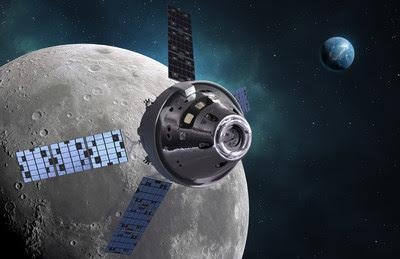Production Starts On Spacecraft That Will Take Astronauts To The Moon
NASA and Lockheed Martin have finalized a contract for the production and operations of six Orion spacecraft missions and the ability to order up to 12 in total. Orion is NASA's deep space exploration spaceship that will carry astronauts from Earth to the Moon and bring them safely home. Lockheed Martin has been the prime contractor during the development phase of the Orion program.

"This contract clearly shows NASA's commitment not only to Orion, but also to Artemis and its bold goal of sending humans to the Moon in the next five years," said Rick Ambrose, executive vice president of Lockheed Martin Space. "We are equally committed to Orion and Artemis and producing these vehicles with a focus on cost, schedule and mission success."
The agency's Orion Production and Operations Contract (OPOC) is an indefinite-delivery, indefinite-quantity (IDIQ) contact for NASA to issue both cost-plus-incentive fee and firm-fixed-price orders. Initially, NASA has ordered three Orion spacecraft for Artemis missions III-V for $2.7 billion. Then in fiscal year 2022, the agency plans to order three additional Orion spacecraft for Artemis missions VI-VIII for $1.9 billion.
OPOC will realize substantial savings compared to the costs of vehicles built during the design, development, test and evaluation (DDT&E) phase.
Up to six additional Orion spacecraft may be ordered under the IDIQ contract through Sept. 30, 2030, leveraging spacecraft production cost data from the previous six missions to enable the lowest possible unit prices.
The first spacecraft delivered on this contract, Artemis III, will carry the first woman and the next man to the Moon in 2024, where they will dock with the Gateway and ultimately land on the surface using a lunar landing system. Orion is a critical part of the agency's Artemis program to build a sustainable presence on the lunar surface and to prepare us to move on to Mars.
Reusable Orion crew modules and systems, use of advanced manufacturing technologies, material and component bulk buys and an accelerated mission cadence all contribute to considerable cost reductions on these production vehicles.
"We have learned a lot about how to design and manufacture a better Orion—such as designing for reusability, using augmented reality and additive manufacturing—and we're applying this to this next series of vehicles. Driving down cost and manufacturing them more efficiently and faster will be key to making the Artemis program a success," said Mike Hawes, Orion program manager for Lockheed Martin Space. "One must also appreciate how unique Orion is. It's a spaceship like none other. We've designed it to do things no other spacecraft can do, go to places no astronaut has been and take us into a new era of human deep space exploration."
Lockheed Martin and NASA recently announced the completion of the Orion crew and service module being developed for the Artemis I mission, an uncrewed mission to the Moon. Work on the spacecraft for the Artemis II mission, the first crewed flight to the Moon, is well underway at the Kennedy Space Center in Florida.
(Image provided with Lockheed Martin news release)
 ANN's Daily Aero-Term (05.09.24): Hold Procedure
ANN's Daily Aero-Term (05.09.24): Hold Procedure ANN's Daily Aero-Term (05.06.24): Altitude Readout
ANN's Daily Aero-Term (05.06.24): Altitude Readout ANN's Daily Aero-Linx (05.06.24)
ANN's Daily Aero-Linx (05.06.24) Airborne-NextGen 05.07.24: AI-Piloted F-16, AgEagle, 1st 2 WorldView Sats
Airborne-NextGen 05.07.24: AI-Piloted F-16, AgEagle, 1st 2 WorldView Sats Aero-News: Quote of the Day (05.07.24)
Aero-News: Quote of the Day (05.07.24)



